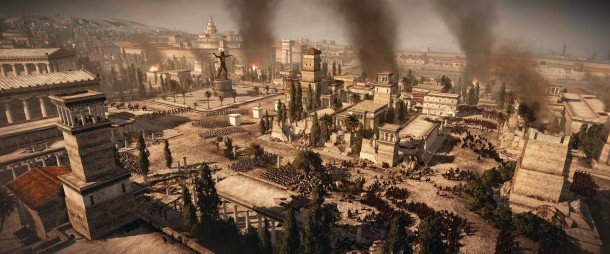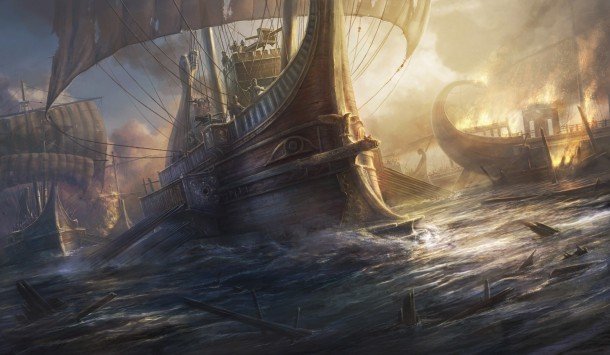Total War Rome 2 preview: every detail about the new engine, naval combat, multiplayer and mods

Reinventing the campaign game
"What we're trying to do is create a game where warfare more meaningful,” Jamie Ferguson told me. “We're placing much more importance on battles, that when an army turns up it is an army. You may find that the campaign game doesn't look like it might have in previous games."
Despite the tease, CA aren't willing to show off anything of Rome 2's campaign map at this stage. The impression I got however was that they're taking a serious and critical look at the structure of the turn-based part of the game, again with an eye to making the player care more about the individual soldiers, cohorts and armies at their command.
"We're ... trying to focus attention on a much smaller number of armies and a smaller number of more significant battles” James Russell explains. “We're trying to reduce the management you've got to do [with] assembling armies, and that kind of thing.”
One example of this kind of refinement will be the ability to govern whole provinces made up of a number of individual regions. Rather than delving into the micromanagement of each individual territory, it sounds like it'll be possible to set policies for an entire region - but when it comes to warfare, each one of those areas will need to be conquered separately. “We still have that strategic depth where a province is made of up several regions which you can conquer”, Russell says. “And what that means is that you can have the benefit of scale but you don't have the management detail.”
Discussing the occurrence of actual historical events during the campaign, Jamie Ferguson stresses that player freedom is still paramount. “We're not putting the player on rails” he explains. “[Events] will be triggered depending on what the player is doing how how the player is behaving... it's really our core goal to integrate the player's interaction with the rich tapestry of the ancient world.”
That integration is key to Total War, he argues. "The point of Total War games isn't just to recreate history. What we're trying to do is get a counterfactual history going. We start from a historical point of view - this is how things were at, lets pick a date at random, 325 BC - and from that point onwards, it's about player action and interaction, with the AI and their environment. That determines how the game develops."

This will apply to everything from political systems to army composition. Using the example of the crown offered to Julius Caesar, Ferguson says that there's no reason that the Roman Republic necessarily needs to become an Empire - it could have historically gone back to a kingship, and if the player chooses to make that decision then that's something Creative Assembly want to support. Likewise, there's nothing - geography and resources aside - stopping a sufficiently well-managed coalition of Germanic tribes from becoming the dominant force of their time.
The biggest gaming news, reviews and hardware deals
Keep up to date with the most important stories and the best deals, as picked by the PC Gamer team.
Giving the player the power to pick the loadout of individual units of troops is something else that Creative Assembly are exploring. “There's no reason that we can't allow the player, maybe, to change the way those units are equipped” Ferguson says. “For example there's the cavalry sword - the spatha. In reality that didn't really become part of standard Roman equipment until very late, in the [Imperial] period - but there's no reason that some general at some point might not have decided, 'well lets do that earlier on'." The idea of history as a sandbox is still at the forefront of Total War's identity.
(Re)designing the ancient world
It's also worth mentioning that Rome 2 looks stunning, and that's as much thanks to its art direction as it is to the new engine. Shogun 2 was rightly praised for having a comprehensive visual identity of its own, and Rome 2 continues that trend - which is even more impressive given how familiar Roman warfare is to a western audience. There's a strong attention to colour and lighting in particular, with Carthage rendered in orange, brown and olive green against the white of its defenders and deep red of the invading Romans. Smoke from fires throughout the city changes the nature of the lighting - in real time, I'm told - diffusing glaring sunlight into a gathering gloom. It's effective, dramatic, believable stuff.
Soldiers' weapons and armour is chipped and looks used, and the walls of cities are adorned with ancient graffiti. This “lived-in” sense is one of the key things that makes Rome 2's design stand out. Despite the prevalence of Rome in film and TV, the team have gone back to original archaeological sources, rebuilt them, and then beaten them up. If Carthage looks this good, I cannot wait to see the Eternal City itself.
Multiplayer and mods
Multiplayer is confirmed, but aside from the fact that Creative Assembly are “planning to do something really big”, no details are available yet. It wouldn't be unreasonable to expect something along the lines of Shogun 2's matchmaking and online campaign systems.
Whether or not Rome 2 will include the content creation tools recently rolled out to Shogun 2 is less clear. “We do our best” James Russell told me. “It has become harder, in the old days we worked with very simple text files that were very easy to mod, now we have a proper authenticated database. We don't necessarily have all the editor tools that the players out there think we do.”
The road to Rome
Total War: Rome 2 is due in 2013. If Creative Assembly can successfully balance revitalising the campaign game with chasing a new, cinematic depth to individual battles then there's every reason to be very excited. More on Rome 2 is available in PCG UK issue 242, out July 4th, and PCG US issue 230, out July 17th. You can also check out our video interviews with the game's lead designers .
Joining in 2011, Chris made his start with PC Gamer turning beautiful trees into magazines, first as a writer and later as deputy editor. Once PCG's reluctant MMO champion , his discovery of Dota 2 in 2012 led him to much darker, stranger places. In 2015, Chris became the editor of PC Gamer Pro, overseeing our online coverage of competitive gaming and esports. He left in 2017, and can be now found making games and recording the Crate & Crowbar podcast.


